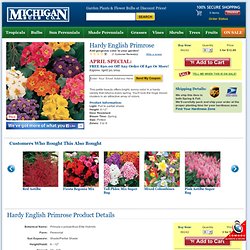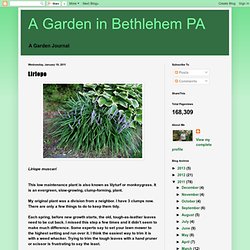

Cimicifuga simplex Hillside Black Beauty - White Flower Farm. Hardy English Primrose from Michigan Bulb. With eye-catching colors like orange, yellow, pink, purple, and white, the Hardy English Primrose is a welcome addition to any garden.

Primrose plants prefer the shade and are exceptionally easy to grow! Unlike other flowers, the hardy primrose doesn't require any pruning. When you're ready to plant your english primrose, you'll need to dig a hole as deep as the pot in which your flower comes in, as this is as much space as it needs to establish and expand its roots.
Once it's re-packed with soil, water your hardy primrose regularly and wait for it to bloom in one of its signature, cheery colors in early spring. The blossoms that result will last though midsummer. A perennial, the Hardy English Primrose will return with its bright flowers year after year if cared for properly. Hardy Fall-Blooming Cyclamen. Add a touch of spring color to your fall garden with late-season hardy Cyclamen (Cyclamen Hederifolium).

These delicate pink flowers resemble perching butterflies balanced on slender stems, a delightful sight in autumn. The flowers arrive before the foliage in this unique cyclamen plant, blooming between September and October, and the heart shaped leaves will keep their attractive patterning and lush green and cream coloration throughout the winter, fading back in the spring. A pleasant fall surprise, place hardy cyclamen under shrubs or around the base of trees for a pick-me-up of pink sweetness as the leaves start falling. They're a great woodland or naturalized garden plant, as well. Cyclamen plants have their dormant period during the summer, so don’t be dismayed when they start to fade in the spring.
Hide that ugly AC unit - FaveThing.com. Hide_that_ugly_ac_unit-3.jpg (569×480) Lavender Astilbe. The feathery, colorful plumes of Lavender Astilbe lend elegance to any garden or dried flower arrangement.

Also known as Astilbe x Arendsii Amethyst, or simply astilbe amethyst, the Lavender Astilbe thrives in places with cool, wet summers, and while it prefers partial- to full-shade areas, it's able to tolerate full sun provided it has plenty of moisture in the soil. This low-maintenance perennial blooms later than other astilbes, providing a burst of color from late June to late August. Once the season turns to autumn, the lavender blossoms turn an attractive bronze color. The hardy stems of the Lavender Astilbe make it a great choice for garden borders, and if you want to enjoy some of your lavender lovelies inside the home, simply cut the flowers to make a fresh arrangement. You can also let them dry out to create an arrangement you'll enjoy year-round. Planting is easy, and there's minimal ongoing maintenance required.
Liriope. Liriope muscari This low maintenance plant is also known as lilyturf or monkeygrass.

It is an evergreen, slow-growing, clump-forming, plant. My original plant was a division from a neighbor. I have 3 clumps now. There are only a few things to do to keep them tidy. Each spring, before new growth starts, the old, tough-as-leather leaves need to be cut back. If you don’t have a weed whacker offer your neighbor a beer to come whack them down. If the clump starts to get too wide, dig it up and divide it immediately. Liriope muscari 'variegata' is a more striking plant. Liriope muscari seems to grow anywhere.
More information from Fine Gardening here. Mixed Coral Bells - Mixed Heuchera from Michigan Bulb. When looking for suitable plants to provide ground cover in your landscape design, look no further than our mixed coral bells.

Heuchera, or coral bells were once widely admired for their spires of reddish flowers. However, its foliage of coral bells are now known as much for the unusual mottling and veining of different-color leaves. The low clumps of long-stemmed evergreen or semi-evergreen lobed foliage make coral bells magnificent choices to be used as ground cover. The flowers are tiny bells on slender stems colored white, pale pink or red and begin blooming in early to midsummer. The foliage of the mixed coral bells may include shades of green, silver, burgundy or caramel. These Mixed Coral Bells grow to a height of eighteen to twenty-four inches and are content in a wide variety of soil types. Salix cinerea 'Tricolor' - Variegated Grey Sallow.
Stella de Oro Dwarf Daylily. Eureka, you've struck gold!

Often the first daylily in the garden to begin blooming, Stella de Oro Daylily, with its glorious deep yellow-gold blossoms, will brighten up any garden space. Cheery 2 -3" trumpet shaped blooms crowd a 15 - 24" stalk, surrounded and enhanced by lush, dark green foliage. This gorgeous dwarf variety is America's favorite daylily, and for good reason. Blooming early, these daylilies will continue to flower throughout the season and often produce a second full bloom in the fall. The compact habit of this dwarf Stella de Oro Daylily makes it perfect for borders, edging walkways, container planting and filling problem areas. Toad Lilies - Japanese Toad Lily.